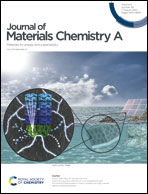Cobalt nitride nanoparticle coated hollow carbon spheres with nitrogen vacancies as an electrocatalyst for lithium–sulfur batteries†
Abstract
The development of high-capacity rechargeable lithium–sulfur batteries is an ongoing challenge because of the shuttle effect, which causes rapid capacity fade, limited rate capability, and slow kinetics. Herein, conductive hollow cobalt nitride/carbon (Co5.47Nx–C) spheres with nitrogen vacancies are developed as a high-performance cathode material for use in lithium–sulfur batteries. Nitrogen vacancies are formed by annealing a zeolite imidazole framework (ZIF-67) precursor in ammonia. Benefiting from its Co–N bonds and nitrogen-vacancy sites, the Co5.47Nx–C composite achieves strong anchoring of polysulfides, fast polysulfide conversion, and accelerated lithium-ion transport. The strong anchoring effect of Co5.47Nx is confirmed by experimental measurements and density functional theory (DFT) calculations. Because of its high conductivity and nitrogen vacancies, the Co5.47Nx cathode exhibits faster redox reaction kinetics and lower polarization than a Co5.47N cathode without nitrogen vacancies, thus realizing promising rate and cycling performance. The optimized Co5.47Nx–C electrode delivers a capacity of 850 mA h g−1 at 0.5C and a rate performance of 320 mA h g−1 at 10C. This high-performance, high-rate lithium–sulfur battery is promising for widespread application in electric vehicles and intelligent devices.



 Please wait while we load your content...
Please wait while we load your content...